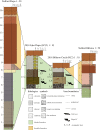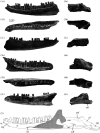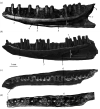A new species of Proegernia from the Namba Formation in South Australia and the early evolution and environment of Australian egerniine skinks
- PMID: 33972861
- PMCID: PMC8074667
- DOI: 10.1098/rsos.201686
A new species of Proegernia from the Namba Formation in South Australia and the early evolution and environment of Australian egerniine skinks
Abstract
The diverse living Australian lizard fauna contrasts greatly with their limited Oligo-Miocene fossil record. New Oligo-Miocene fossil vertebrates from the Namba Formation (south of Lake Frome, South Australia) were uncovered from multiple expeditions from 2007 to 2018. Abundant disarticulated material of small vertebrates was concentrated in shallow lenses along the palaeolake edges, now exposed on the western of Lake Pinpa also known from Billeroo Creek 2 km northeast. The fossiliferous lens within the Namba Formation hosting the abundant aquatic (such as fish, platypus Obdurodon and waterfowl) and diverse terrestrial (such as possums, dasyuromorphs and scincids) vertebrates and is hereafter recognized as the Fish Lens. The stratigraphic provenance of these deposits in relation to prior finds in the area is also established. A new egerniine scincid taxon Proegernia mikebulli sp. nov. described herein, is based on a near-complete reconstructed mandible, maxilla, premaxilla and pterygoid. Postcranial scincid elements were also recovered with this material, but could not yet be confidently associated with P. mikebulli. This new taxon is recovered as the sister species to P. palankarinnensis, in a tip-dated total-evidence phylogenetic analysis, where both are recovered as stem Australian egerniines. These taxa also help pinpoint the timing of the arrival of scincids to Australia, with egerniines the first radiation to reach the continent.
Keywords: Egerniinae; Miocene; Oligocene; Scincidae; palaeontology.
© 2021 The Authors.
Figures














Similar articles
-
Phylogeny and divergence times of Australian Sphenomorphus group skinks (Scincidae, Squamata).Mol Phylogenet Evol. 2013 Dec;69(3):906-18. doi: 10.1016/j.ympev.2013.06.014. Epub 2013 Jun 28. Mol Phylogenet Evol. 2013. PMID: 23810993
-
Built for success: Distribution, morphology, ecology and life history of the world's skinks.Ecol Evol. 2023 Dec 12;13(12):e10791. doi: 10.1002/ece3.10791. eCollection 2023 Dec. Ecol Evol. 2023. PMID: 38094152 Free PMC article.
-
Two fossil species of Metrosideros (Myrtaceae) from the Oligo-Miocene Golden Fleece locality in Tasmania, Australia.Am J Bot. 2017 Jun;104(6):891-904. doi: 10.3732/ajb.1700095. Epub 2017 Jun 20. Am J Bot. 2017. PMID: 28634257
-
Review of the monotreme fossil record and comparison of palaeontological and molecular data.Comp Biochem Physiol A Mol Integr Physiol. 2003 Dec;136(4):927-42. doi: 10.1016/s1095-6433(03)00275-7. Comp Biochem Physiol A Mol Integr Physiol. 2003. PMID: 14667856 Review.
-
Biogeography and speciation of terrestrial fauna in the south-western Australian biodiversity hotspot.Biol Rev Camb Philos Soc. 2015 Aug;90(3):762-93. doi: 10.1111/brv.12132. Epub 2014 Aug 15. Biol Rev Camb Philos Soc. 2015. PMID: 25125282 Review.
Cited by
-
First record of a tomistomine crocodylian from Australia.Sci Rep. 2021 Jun 9;11(1):12158. doi: 10.1038/s41598-021-91717-y. Sci Rep. 2021. PMID: 34108569 Free PMC article.
-
Make Acetylcholine Great Again! Australian Skinks Evolved Multiple Neurotoxin-Proof Nicotinic Acetylcholine Receptors in Defiance of Snake Venom.Int J Mol Sci. 2025 Aug 4;26(15):7510. doi: 10.3390/ijms26157510. Int J Mol Sci. 2025. PMID: 40806638 Free PMC article.
-
Compound osteoderms preserved in amber reveal the oldest known skink.Sci Rep. 2024 Jul 8;14(1):15662. doi: 10.1038/s41598-024-66451-w. Sci Rep. 2024. PMID: 38977836 Free PMC article.
-
A giant armoured skink from Australia expands lizard morphospace and the scope of the Pleistocene extinctions.Proc Biol Sci. 2023 Jun 14;290(2000):20230704. doi: 10.1098/rspb.2023.0704. Epub 2023 Jun 14. Proc Biol Sci. 2023. PMID: 37312544 Free PMC article.
References
-
- Hall R. 2002. Cenozoic geological and plate tectonic evolution of SE Asia and the SW Pacific: computer-based reconstructions, model and animations. J. Asian Earth Sci. 20, 353-431. (10.1016/S1367-9120(01)00069-4) - DOI
-
- White ME. 2006. Environments of the geological past. In Evolution and biogeography of Australasian vertebrates. (eds Merrick JR, Archer A, Hickey GM, Lee MSY), pp. 17-48. Oatlands, NSW: Auscipub.
-
- Skinner A, Hugall AF, Hutchinson MN. 2011. Lygosomine phylogeny and the origins of Australian scincid lizards. J. Biogeogr. 38, 1044-1058. (10.1111/j.1365-2699.2010.02471.x) - DOI
-
- Oliver PM, Sanders KL. 2009. Molecular evidence for Gondwanan origins of multiple lineages within a diverse Australasian gecko radiation. J. Biogeogr. 36, 2044-2055. (10.1111/j.1365-2699.2009.02149.x) - DOI
Associated data
LinkOut - more resources
Full Text Sources
Other Literature Sources

